The Jaeger weighs 6 1/2 pounds including the (new) sling and has a pull of 12 3/4" and a drop of 2". It fits my shoulder perfectly, and lifting it into position puts the sights aligned and on target. The balance is perfect for fast target acquisition, such as a charging boar, and it could easly be fired one-handed from horseback (if the horse didn't object...). The rear sight has a second leaf which provides 13" elevation at 100 yards, which is about what one would expect for a 60 caliber round ball with a muzzle velocity of 1200 fps on a gun sighted in at 25 yards.
The Lock

The lock-plate is signed 'J G DACHTINE AAIX' below and around the pan, and 'LACHAPELLE'
centered under the frizzen spring. This translates to 'J.G. Dachtine at Aix-La Chapelle', which is the
French name for the German city of Aachen, which sits on the border of Germany and Belgium, slightly North East of Liege.
J.G. Dachtine is known for producing high-end and mechanically complicated firearms in the latter part of the
18th Century, including an enclosed 'waterproof' flintlock mechanism. This French-style 1780's
lock is extremely well-made, with a sliding safety plate behind the hammer and a high degree of internal
finishing. Note that clicking on any image here will bring up a much larger version.
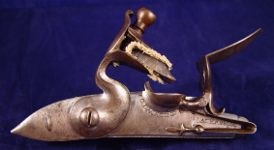 |
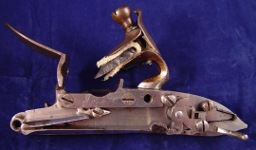 |
The 23 3/4" swamped barrel measures 1.13" wide at the breech, 0.82" at the waist and 1.04" at the muzzle. The bore is approximately 0.61" with seven grooves at about 0.635"; a 0.580" ball with a 0.018" patch provides a tight fit, but the very deep grooves may have been intended for a leather patch or for additional wadding to prevent gas blow-by. The stout iron original ramrod suggests that whatever combination was used, it was very tight and needed some 'persuation' to get it down. On the top of the breech is a gold inset with the gunmakers initials 'JGD' and a separate inset bearing the eagle insignia of Aachen.
Decoration
For an arm bearing a princely emblem, there is only modest decoration, but what there is, is well-done. Aside from the cartouche on the top of the wrist, there is engraved furniture, including a strap which strengthens the traditional carved wooden trigger guard.
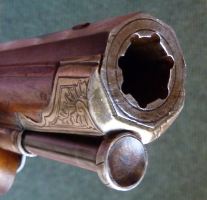 |
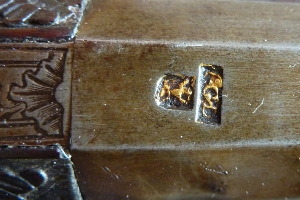 |
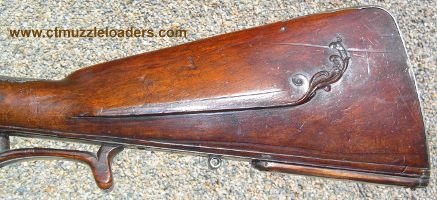 |
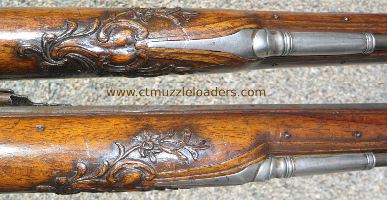 |
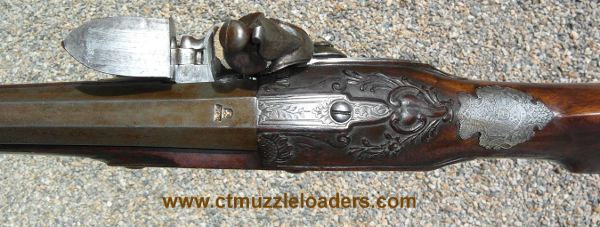 |
 |
 |
The Prince
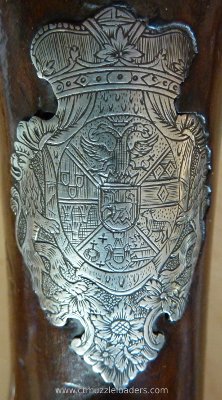 |
Unfortunately for anyone tracing the provenance of this Jaeger, there were literally hundreds of principalities and German statelets at the time this rifle was made, and there were even more noble crests. The double-headed eagle holding the sword and orb is a part of the crest of the Holy Roman Emperor and is also common in Prussian heraldry. I would be interested to see if any readers can find a more definitive origin for this crest.
So, in the end we have a Jaeger which was well-built by a prestigious maker of the time. The decoration does not come up to the standards of the best courtly weapons, but it was clearly made for some noble house (no one else could have afforded it). It may have been an armory piece or designed to be used by a huntsman, or even the Prince himself - if there actually was a Prince...
Historical Update
A reader has identified the coat of arms as belonging to the House of Schoenborn, a large and prominent family dating from the Middle Ages with extensive interests continuing today. In the church of Schwemmelsbach there is a coat of arms almost identical to that on the rifle.
Performance and Video
The jaeger was tested with a light 'trail walk' load and hunting loads. The recoil was slight with the lighter loads and only moderate with the 'hunting' load.
| Charge | MV | fpe |
| 50 gr | 1058 fps | 727 |
| 70 gr | 1275 fps | 1056 |
| 100 gr | 1545 fps | 1550 |
| Click on the image to see a video about the rifle. | 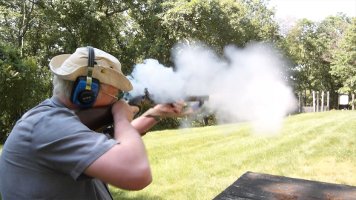 |


